#st. nicholas' church museum
Text
Tallinn
Tallinn was a pleasant surprise, more enjoyable perhaps than Helsinki, from where I caught a ferry across the Baltic Sea to Estonia. Tallinn is by far the largest city in Estonia, but it is a small country. It had a lovely old town but the new town was also surprisingly attractive in places, and home to two incredible museums.
Lennusadam is part of the Estonian Maritime Museum, and is probably…

View On WordPress
#Alexander Nevsky Cathedral#Danish King&039;s Garden#Estonia#Great Coastal Gate#Kohtuotsa viewing area platform#Lennusadam#Long Leg Gate Tower#Maarjamäe Castle Estonian History Museum#Patkuli viewing platform#photography#Piiskopi viewing platform#St Mary&039;s Cathedral#St Olaf&039;s Church#St. Nicholas Church and Museum#Tallinn#Tallinn City Hall#Toompea Castle#travel#Viru Gates
0 notes
Text
Wedding dress, made in 1841





Sarah Maria Wright (1817 – 1908) wore this dress for her marriage to Daniel Neal (1816 – 1907) on 27 July 1841 at St. Nicholas' Church in Skirbeck, Lincolnshire. It was donated together with a spelling book which she inscribed with her name on February 15th, 1826.
In the 1851 census Daniel is described as living at Woad Farm House in Skirbeck, Lincolnshire, where he was probably working as a labourer in the production of woad. The dress therefore reveals the type of clothing rural labourers' wives might wear for their weddings. Such objects tend to survive in much smaller quantities than fashionable wedding dress as they would have been worn for Sunday best long after the event, or handed down.
Sarah chose a fashionable design for her dress with its full sleeves, low neckline, gathered shoulders and full skirt. It is, however, made of printed cotton which would have been cheaper than the silks and challis fabrics of costlier wedding dresses. The print is a copy of more expensive designs which again adds interest as such textiles do not tend to survive.
Victoria and Albert Museum
#19th century#fashion history#historical fashion#victorian#victorian era#victorian fashion#wedding dress
86 notes
·
View notes
Text
Random saints by Sittow or Catherine of Aragon's parents?

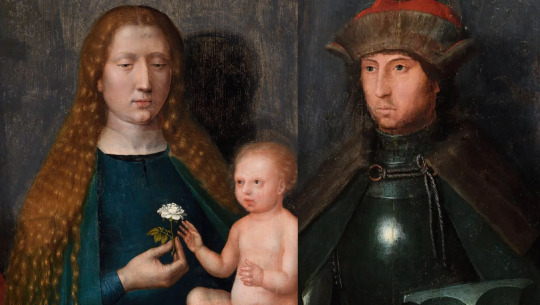
Read further if you wish to know what my theory is.
I first found this photo with mention it is by Sittow and at first I thought it is another portrait of Catherine. But quickly I realised this woman looks older and the features are not exactly the same.
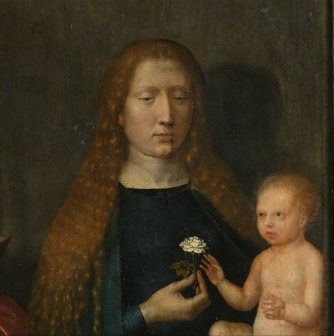
The nose is much narrower. And I started to wonder...we know that Sittow painted at least one portrait of Queen Isabella I of Castile.
And she had such nose. I could exclude possibility some of Catherine's sisters looked like this too, but women in that family tended to be very young-looking for really long.
So the age of sitter already is suggesting that it could be based upon Isabella towards end of her life. And it is also odd for depiction of Virgin Mary to depict woman who is not young...it is point in Isabella's favour.
While many claim Sittow painted Isabella in 1485, he was only born in 1468/1469 and didn't even become indipended master until at least 1488. He is first recorded working in Toledo in 1492. So he'd always be only able to depict Isabella over age of 40. And tbh, if this is her..then she looks great for somebody over 40!
But where is this image? It took me while to track down.
It's detail from wings of theThe Passion Altarpiece (Tallinn), its middle part is from c.1515-1520(with some 17th century additions) by different artist.

But I am not so sure how accurate is the dating of the outer wings by Sittow(1518-1525) which are in very different style, and might have originally belong to different altar middle.

If it is indeed 1518-1525 dating, then imo they are posthumous depictions based upon earlier sketches done from life. Sittow reusing those old sketches, using them as inspiration for his later work.
Link to photos only. Left pannel: https://artsandculture.google.com/asset/the-passion-altarpiece-outer-wing-with-the-virgin-mary-and-apostle-james-the-greater-paintings-of-the-outer-side-of-the-wings-by-michel-sittow-and-his-workshop/BwFnRG1v6gRqmQ
Right pannel: https://arthive.com/artists/75951~Michel_Sittow/works/526786~Saint_Adrian_and_Saint_Anthony
As to where they are located?
-Niguliste Museum(housed in former St. Nicholas' Church), which is part of Art Museum of Estonia(which combines collections from 3 other buildings+ this church). Hence in Tallin, Estonia but be aware there is over 3 km distance in between the church and other buildings.
But if anybody could go there and get us some pictures it'd be great (if it is allowed). Currently Niguliste Museum has exhibition about Sittow:

But back to the pannels. The left one depicts Madonna(Virgin Mary holding baby Jesus) and St. James the Great(apostle and patron saint of Spain:
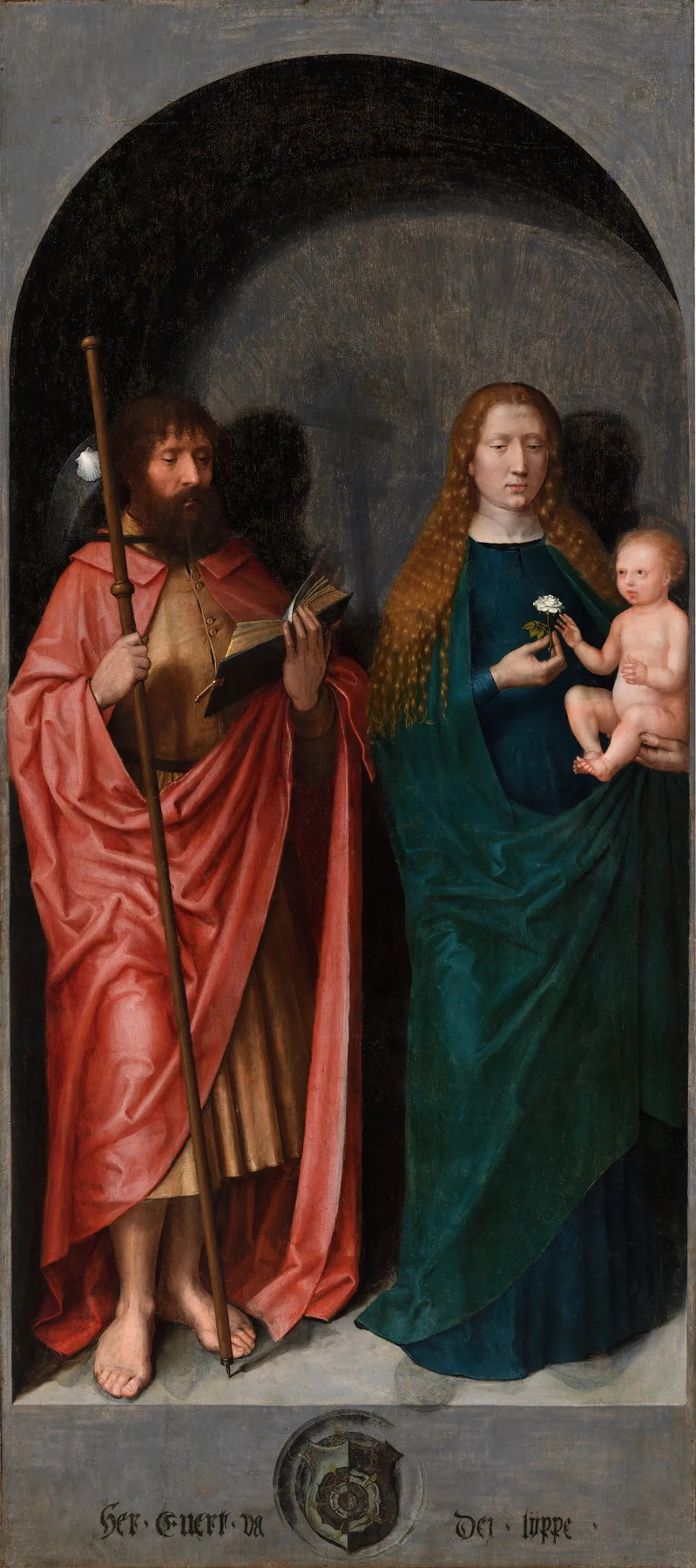
And please note that Tudor rose is combination of red and white rose and not always it was depicted as inner rose white, outer red. Sometimes they were halfed, with inner rose sometiems also switched.

Of course it could be some foreign coat of arms or later alteration.
Right pannel:

Here the coat of arms looks much newer and is probably altered(and if pomegranate turned out to be beneath it, I'd just die...)
The right pannel is depicting two male saints. On right is St Anthony the Great...was father of monasticism(of monastic life)...thus very important saint in christianity...
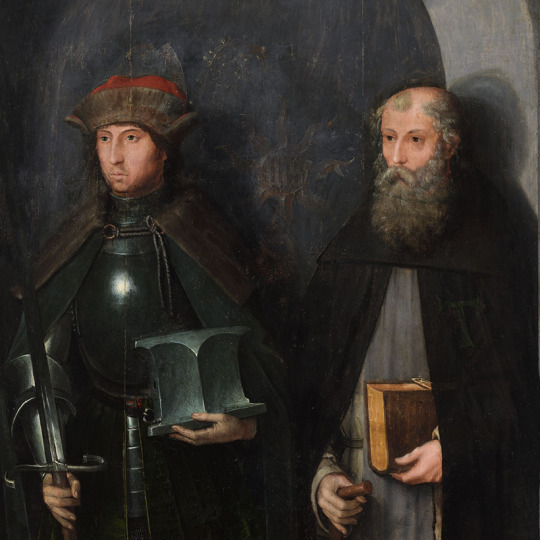
and on left St. Adrian of Nicomedia(2nd most popular military saint after St. George), and imo that's probably King Ferdinand II of Aragon:

It's not great likeness(brows not arched enough, looks bit slimmer, alla of nose not as defined), but overall it's enough of resemblence to not be able to exclude the possibility.
But if this is indeed done years after Sittow was in Spain...and he is reusing his old sketches of catholic monarchs to create this new religious scene(perhaps initially intended for them too, but never made into finished work before), then it is also possible that sketch done in pencil has partially rubbed off...and thus the differences in face of this male.
I think that if this was done while in Spain, such big differences are not very likely to occur. Not that pencil could not rub off, but I think Sittow would have noticed and cared about getting absolutely righ(to please his patrons) and thus would have corrected it.
Ehm, this kitty is supposed to be a lion:
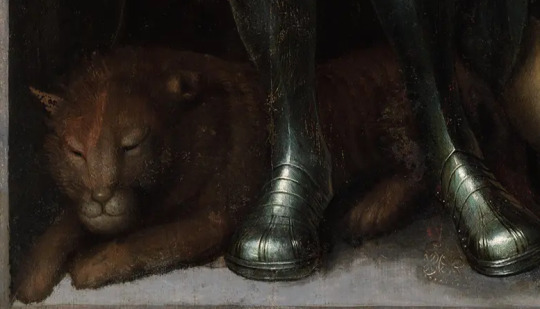
But you must be wondering, if Isabella indeed had this most vivid golden hair colour I always go on and on about, why does she have red hair here?
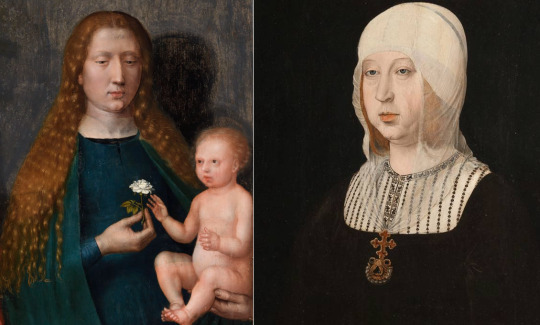
Several options to pick from: Pigments going wrong, Isabella's hair possibly turning to more reddish hues towards end of her life, or simply discoloured pinkish varnish which was very oddly applied...and on baby's skin you can see where somebody applied only one layer and where they went with brush for 2nd time.
If entire pannel has this varnish on, then it'd affect the hair, turning it more red. Why would such varnish not be removed? Sometimes money is tight and museums have multiple paintings to care for and those paintings in fairly good condition have to wait longer.
And sometimes it is not possible to remove discoloured varnish without harming the painting beneath.
Also worth of nothing is that Virgin Mary's dress is typically not teal, but vividly blue, the very best most expensive most vivid blue pigments were very often reserved for depicting the Virgin Mary:

Sometimes due to budget cost cheaper substitues were used, and those tend to fade.
Hence imo the colours originally might have been intended to be more like this(yes, I photoshopped it):

(I didn't change damn thing about male figure, just brightened it. But tbh I played with the woman's dress, skin and hair for while.)
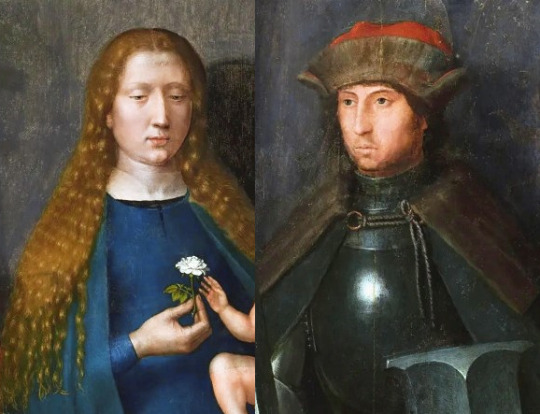
I mean if it looked like this now, fans of catholic monarchs would probably be all over it already.
But people overlook these dark slightly pinkish images located all the way in Estonia, even though it is atributed to Sittow himself!
(I don't mean people in Estonia, I mean people who search for Isabella's lost portrait by Sittow and stubbornly stuck to their favourite which is not even by Sittow!)

I honestly thought that people searching for lost portrait of Isabella by Sittow would have by now checked all his work, to see if perhaps she is there somewhere! Just doesn't look teen or young adult.
So I want you to be aware, if you're on quest of finding Isabella by Sittow's in that portrait with emerald necklace that this is imo the face you're looking for :

Possibly with hair bit more golden and skin more fair:
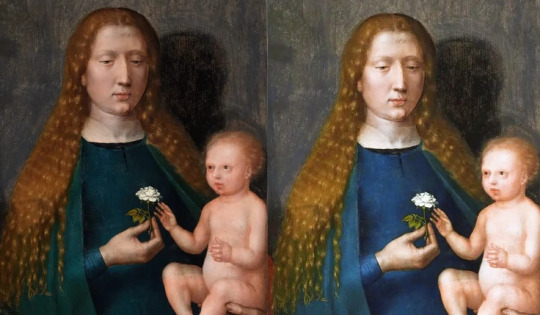
And it doesn't matter she doesn't look 20! She is still very beautiful.
Hence imo, these are Catherine of Aragon's parents, depicted in disguise of saints:

But I think they were likely painted years after Sittow left Spain, and his old sketches of them have been reused to create these pannels. I hope the experts will one day look more into this possibility.
I hope you've enjoyed this, and tell me what you think. Am I onto something or am I chasing shadows?


#historical portraits#isabella of castile#ferdinand of aragon#Isabella I of Castile#Ferdinand II of Aragon#sittow
72 notes
·
View notes
Text

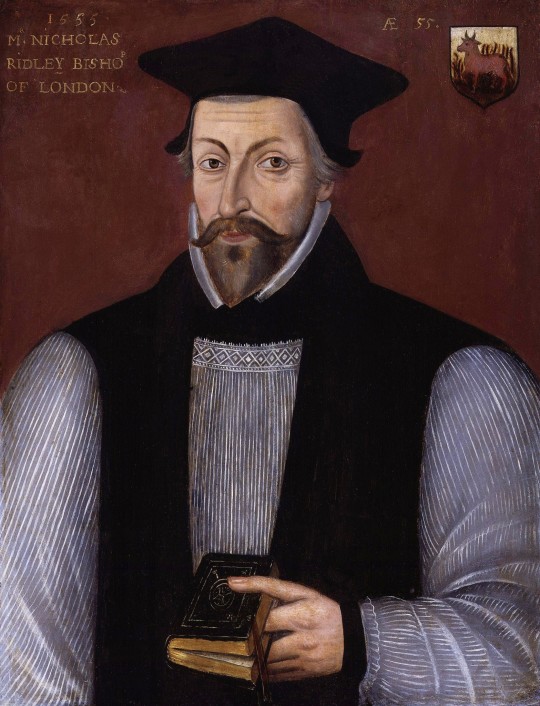



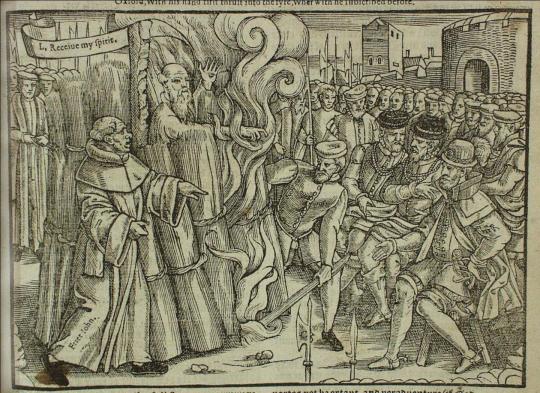
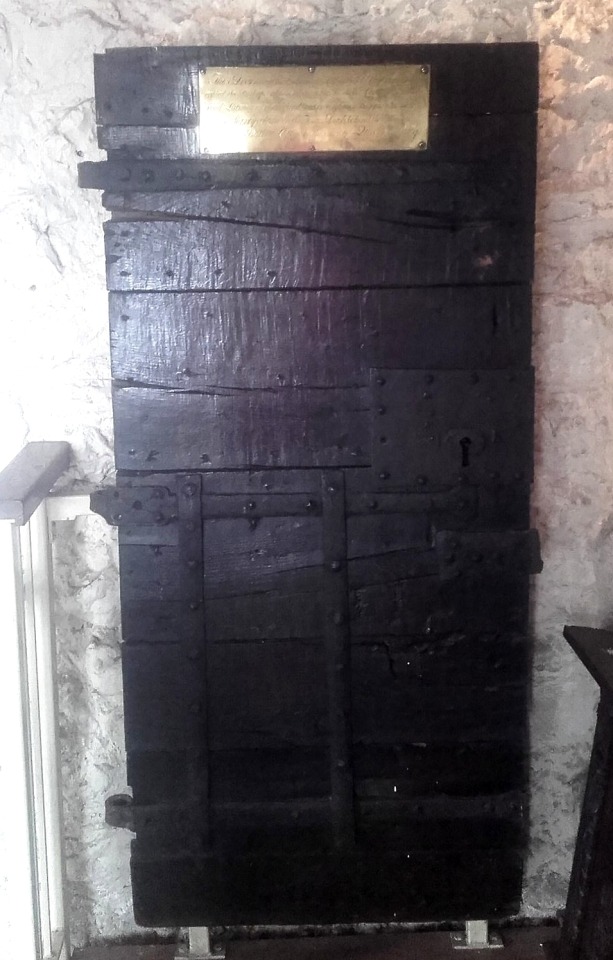
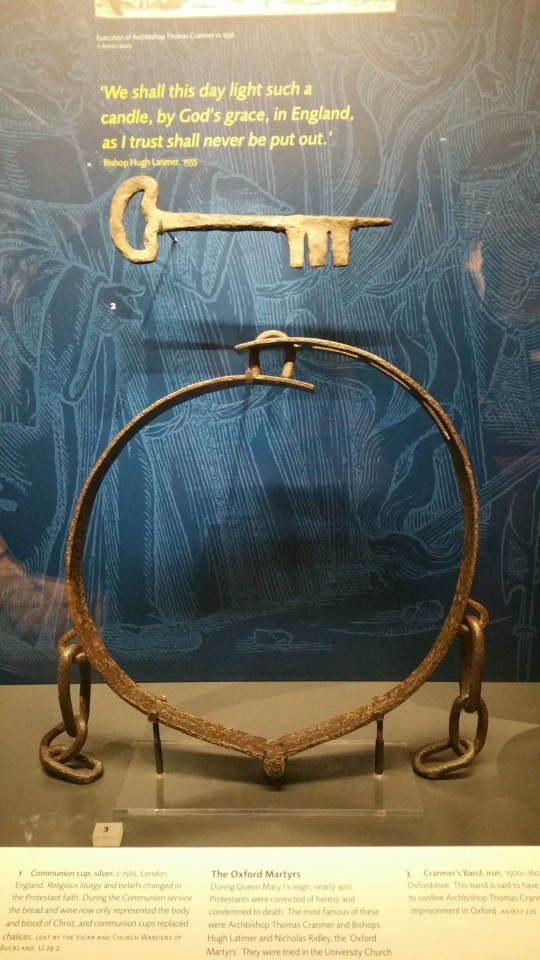
The 16th of October marks the commemoration by the Church of England of the Oxford Martyrs, Anglican bishops Nicholas Ridley, Hugh Latimer, and Thomas Cranmer, who were burned at the stake in Oxford for heresy under the reign of Mary I. Ridley and Latimer were burned together on that day in 1555; Cranmer's execution would be five months later.
They were some of the most high-profile figures executed during Mary's reign, having been respectively Bishop of London, Worcester, and Archbishop of Canterbury under the previous reign. They had also been singled out for their efforts to delegitimize Mary's claim to the throne; Cranmer had made the official pronouncement that annulled Henry VIII's marriage to Catherine of Aragon, thereby removing their daughter Mary from the line of succession, and Ridley had been instrumental in declaring Lady Jane Grey the successor to Edward VI, once again claiming Mary's illegitimacy.
The bishops made the most of the public spectacles of their executions, ensuring their legacy as religious martyrs. Latimer is quoted as having said "Be of good comfort, and play the man, Master Ridley; we shall this day light such a candle, by God's grace, in England, as I trust shall never be put out." Cranmer meanwhile had been pressured into signing a recantation of his Protestantism with a promise of leniency, but this was overruled by Mary herself, possibly because of her long-standing resentment of the role Cranmer has played in dissolving her parents' marriage. Once at the stake, Cranmer renounced his recantation, declared the Pope the Antichrist, and put his "unworthy hand" that had signed his presentation first into the fire.
Commemorations of the Martyrs can be found throughout Oxford; memorials are present in St. Mary's Church where the men were tried and convicted, the spot where the executions were held, and an ornate monument with statues of the three. The door to Cranmer's prison cell is preserved in the neighboring St. Michael's Church, and the Ashmolean Museum houses the key to the cell alongside the metal band said to have fastened Cranmer to the stake.
31 notes
·
View notes
Text

The Rock Crystal Egg or Revolving Miniatures Egg is an Imperial Fabergé egg, one in a series of fifty-two jeweled eggs made under the supervision of Peter Carl Fabergé for the Russian Imperial family. It was created in 1896 for Empress Alexandra Fyodorovna. The egg currently resides in the Virginia Museum of Fine Arts.The egg was created by Faberge's workmaster, Mikhail Evlampievich Perkhin (Russian, 1860–1903) with miniatures by Johannes Zehngraf (Danish, 1857–1908)[2] It stands about 248 mm (9 3/4 in) tall on its stand, with a diameter of 98 mm (3 7/8 in.)[3] The outer shell is rock crystal banded with emerald-green enameled gold studded with diamonds. On the apex of the egg is a 27-carat (5.4 g) Siberian emerald supported by an emerald-green enameled gold mount. This cabochon-style emerald is one of the largest gemstones Fabergé used in any of the Imperial eggs.[4] The egg's base sits on a plinth of rock crystal. The base consists of a colorfully enameled gold double spheroid which is circled twice with rose-cut diamonds. It has the monograms of the Tsarina, as the Princess Alix of Hesse-Darmstadt before her marriage, and later as Alexandra Fedorovna, Empress of Russia. Each monogram is surmounted with a diamond crown of the respective royal house.[4] These monograms form a continuous pattern around the base of the egg.Inside the rock crystal egg is a gold support holding twelve miniature paintings. The paintings are of the various palaces and residences that were significant to the Empress. Each location holds a special memory for Nicholas and Alexandra in the early days of their courtship, as they had just been married two years prior, in 1894.
When the large cabochon emerald on the apex is depressed it engages a mechanism that rotates the miniatures inside the egg. A hook moves down and folds the framed pictures back, like the pages of a book, so two paintings can be fully seen at one time.[1] Each miniature is framed in gold with an emerald on the apex. The frames are attached to a central fluted gold shaft which passes vertically through the egg.[4]
The locations include:
The Neues Palais, Darmstadt, Germany: Palace where the Empress was born.
Kranichstein, Hesse: A favorite summer residence of the Empress' youth.
Balmoral Castle, Scotland: Childhood holiday destination of Alexandra's grandmother, Queen Victoria.
Old Grand Ducal Palace (Altes Palais), Darmstadt: Official seat of Alexandra's father, Ludwig IV, Grand Duke of Hesse.
Wolfsgarten, Hesse: Hunting lodge Alexandra's family visited as a child.
Windsor Castle, near London, England: A residence of Queen Victoria where Alexandra visited as a child.
Palace Church, Coburg: Site where Alexandra first consented to marry Nicholas.
Schloss Rosenau, Coburg: A site Nicholas and Alexandra visited the day after their engagement.
Osborne House, Isle of Wight: Site of Nicholas' visit to see Alexandra while they were engaged.
The Winter Palace, St. Petersburg: The site of Nicholas and Alexandra's wedding.
Anichkov Palace, St. Petersburg: Residence of Maria Feodorovna, where Alexandra spent her first year in Russia.
The Alexander Palace, Tsarskoe Selo, near St. Petersburg: the Imperial family's favorite winter residence.The egg was presented by Nicholas II to Alexandra Fedorovna on March 24, 1896. She received it at Eastertide in the same year that the young couple had suddenly ascended the throne.[1]
In 1909 the egg was housed in the Empress' study in the Winter Palace. The egg was seized by the Kerensky Provisional Government and moved to the Armory Palace of the Kremlin in Moscow along with approximately 40 other eggs. In 1930, the Rock Crystal Egg was one of the ten Eggs sold by the Antikvariat (Trade Department) to the Hammer Galleries in New York for 8000 rubles, or approximately $4000 U.S. In 1945 the egg became the last of five Imperial Easter Eggs bought by Lillian Thomas Pratt, the wife of a General Motors executive John Lee Pratt. Upon Lillian Thomas Pratt's death in 1947, the egg was willed to Virginia Museum of Fine Arts, Richmond, Virginia. It remains on view as part of the Virginia Museum of Fine Art's European Decorative Art collection
49 notes
·
View notes
Text
Feodorovsky Gorodok and Feorodovsky Cathedral

FEODOROVSKY GORODOK
Across Alexander Park, down the path from the Alexander Palace, is Feodorovsky Gorodok, a tiny old Russia-style town built by Nicholas II in the first decade of the 20th century. The Tzar wanted the town to have the atmosphere of an old Russian town. This historic atmosphere would frame the Alexander Palace.
The Feodorovsky Gorodok (Town), included the Feodorovsky Sovereign Cathedral, the Martial Chamber, the infirmary of Grand Duchesses Anastasia and Maria, the former barracks of His Imperial Majesty’s Own Convoy, and the Tsar’s Railway Pavilion. There was much more Nicholas wanted to do in the Gorodok, but the First World War halted his plans, while the revolution ended them completely. The buildings surviving unchanged are the Feodorovsky Cathedral and the Martial Chamber (now the Museum of the History of the First World War).
Reportedly, the restoration of the Gorodok has begun. The area has not been completely abandoned: A fully functioning privately owned restaurant is in one of the courtyards. The former Grand Duchesses Maria and Anastasia’s infirmary and the buildings in the courtyard behind it have been converted to boarding rooms for the elderly who are too poor to afford housing and food.

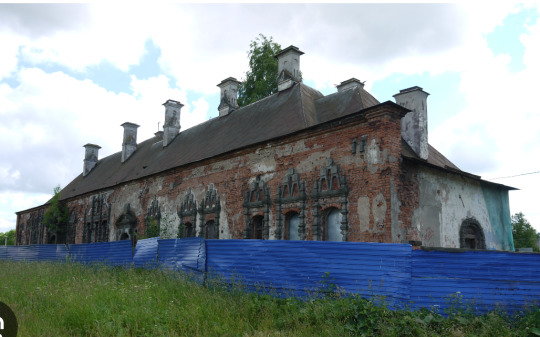
1. The Tsarkoe Selo Train Station as it stood in the 20th century 2. What is left of the station, which is being restored

3. The barracks of his Imperial Majesty's Own Convoy


4. Maria and Anastasia's Infirmary. 5. Maria and Anastasia posing with officers at the entrance of the infirmary.


6. Badly damaged wall and tower. 7. Restoration work taking place.

FEODOROVSKY SOVEREIGN CATHEDRAL
The foundation of the Cathedral was laid on 20 August 1909, in the presence of Emperor Nicholas II and his family. The construction was financed by the tsar’s family.
The Feodorovsky Sovereign Cathedral became the house church for Emperor Nicholas II and his family. The Cathedral consisted of two churches, the upper which included the main altar dedicated to the Feodorovsky Icon of Our Lady and a side-chapel consecrated in honor of the Moscow Metropolitan Alexis, the all-Russia Miracle-Worker. The lower part of the Cathedral housed a Cave Church with the altar consecrated in the name of Saint Serafim of Serov the Miracle-Worker, and the private chapel of Emperor Nicholas II and Empress Alexandra Feodorovna. The Feodorovskaya icon of Our Lady, the main icon of the Cathedral, is the patroness of the Romanov dynasty. The icon was kept in the upper church.
In 1913-1917 the Martial Chamber complex was built near the cathedral. At the start of the war against Germany in 1914 it was decided to open a portrait gallery of the holders of the St. George Cross in the Chamber building. In 1918 the art collections were divided among various museums in Leningrad.
In 1991 the Feodorovky Sovereign Cathedral opened its doors to believers again. The entire complex of buildings is closely connected with the Russian Orthodox Church and with the life of the last Russian Emperor; the church allocates funds for the restoration work. The Feodorovsky Sovereign Cathedral was reconsecrated on 29 February 1992. Regular liturgies are carried out in the Cave Church. Renovation of the Cathedral was finished in 2013, the 300th anniversary of its original construction.







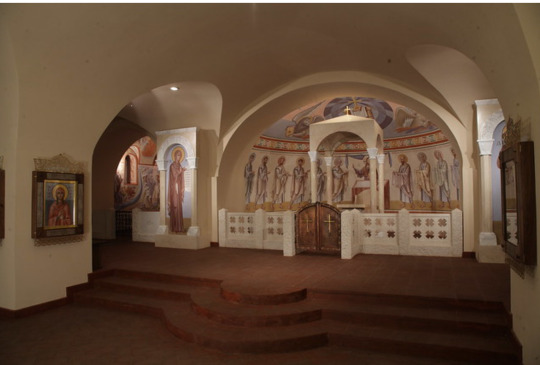
Inside view - the icons of Alexandra and Nicholas can be seen in the background
Main entrance
Outside view of the cathedral and a bust dedicated to Nicholas II
A view of the inside
Entrance to the "cave church" where the Emperor and his family worshipped
The Emperor's Stairs (to the lower church)
The lower church as it looks today. No photos were located for the intimate atmosphere of this chapel to be recreated. The design is modern.
#russian history#imperial russia#romanov family#Tsarkoe Selo#Nicholas II#Feodorovsky Godorov#Feodorovsky Sovereign Cathedral#OTMA
12 notes
·
View notes
Text
Historic Centres of Stralsund & Wismar
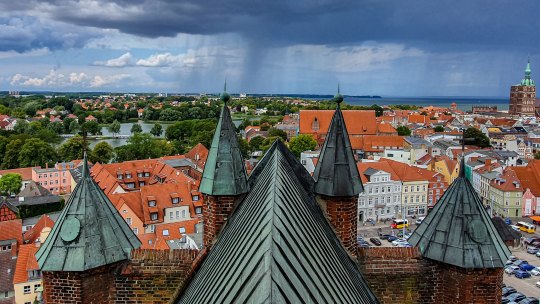
Embark with me on a virtual journey to the historic centers of Stralsund and Wismar, two enchanting Hanseatic cities nestled along the Baltic Sea in Germany. Recognized as a UNESCO World Heritage Site, these coastal gems beckon with their medieval charm, maritime legacies, and a tapestry of architectural wonders that echo the stories of centuries past.
Discover the rich Hanseatic history that binds Stralsund and Wismar. As key members of the Hanseatic League, these cities thrived as trading hubs, fostering cultural exchange and economic prosperity during the medieval period.
Step into Stralsund's Old Town, where gabled houses, Gothic churches, and historic market squares transport you back to the heyday of the Hanseatic League. Marvel at the imposing St. Mary's Church and the iconic Rathaus (Town Hall), testaments to the city's architectural prowess.

Wander through Wismar's expansive Market Square, surrounded by elegant Renaissance-style buildings that showcase the city's prosperity. The Wasserkunst fountain, a symbol of Wismar's maritime achievements, stands as a centerpiece in this historic square.
Admire the Brick Gothic architecture that defines both cities. From Stralsund's iconic St. Nicholas' Church to Wismar's St. George's Church, the red-brick structures stand as enduring symbols of the region's medieval craftsmanship.
The historic centers of Stralsund and Wismar received UNESCO recognition in 2002. The inscription acknowledges their well-preserved urban layouts, architectural ensembles, and maritime heritage, illustrating the symbiotic relationship between land and sea.
Explore the maritime museums in both cities, where exhibits showcase the maritime prowess that fueled their economic prosperity. From shipbuilding to seafaring, these museums offer a glimpse into the seafaring traditions that shaped Stralsund and Wismar.

Immerse yourself in the harbor views of both cities, where the rhythmic ebb and flow of the Baltic Sea have shaped their identities. The harbors are not just gateways to the sea but reflections of the maritime soul that runs deep in the veins of Stralsund and Wismar.
Partake in the vibrant festivals and cultural events that animate these historic centers. From medieval fairs to maritime celebrations, these events breathe life into the cobblestone streets, fostering a sense of community and celebration.
In conclusion, the historic centers of Stralsund and Wismar stand as living testaments to the resilience of Hanseatic heritage and the enduring beauty of coastal cities. As a UNESCO World Heritage Site, they invite us to traverse their medieval streets and harbor fronts, where the echoes of history resonate with each step. When you're ready for a digital sojourn through time, Stralsund and Wismar promise to captivate and inspire. 🏰🌊🇩🇪
#historic#center#wismar#stralsund#culture#unesco#world heritage#city#town#hanseatic#league#baltic#sea#travel#germany#europe
2 notes
·
View notes
Text
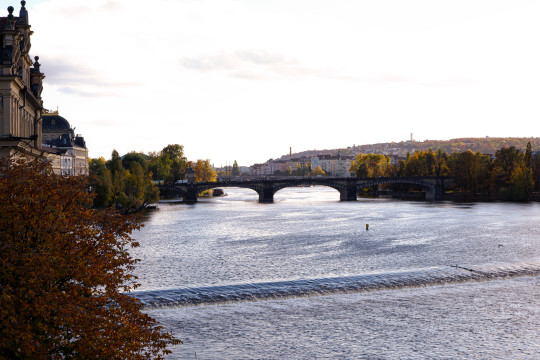
Prague Itinerary
Day 1:
Old Town Square - FREE
St Nicholas Church - FREE
Astronomical Clock - FREE
Church of Our Lady - FREE
The house at the black Madonna - FREE
Prajna Brama - FREE
Basilica of St James (mummified hand) - FREE
Day 2:
Man Hanging Out statue - FREE
Charles Bridge - FREE
Lennon’s Wall - FREE
Kafka Museum - £10
Museum of Alchemists and Magicians of Old Prague - £8
Klementinum Library and Astronomical Tower Tour - £10
Absintherie Jilská Bar
Vegan’s Prague - Dinner
Day 3:
Prague Castle - £9
St. Vitus Cathedral - FREE
St George’s Basilica - FREE
Zlota Uliczka - FREE
Strahov Monastery - £5
Kafka’s Head - FREE
Mucha Museum - £12
Dancing House - FREE
2 notes
·
View notes
Text
Holidays 5.22
Holidays
Abolition Day (Martinique)
Bălți Day (Moldova)
Bear Waking Day (Norway)
Buy A Musical Instrument Day
Canadian Immigrants' Day
Carpet Day (Turkmenistan)
Clover Day (French Republic)
Dia do Abraço (National Hugging Day; Brazil)
EMS Education Day
Ethernet Day
Ewokalypse
Find Your Soul Mate Day
Flag Adoption Day (Australia)
Goth Day
Growing Flavor in the Garden Day
Harvey Milk Day (California)
Heat Awareness Safety Day
International Being You Day
International Coco Mom Day
International Day For Biological Diversity (UN)
International Day of Syndrome 22q11
International Sherlock Holmes Day
Jumping Frog Jubilee Day (Angel's Camp, California)
Lee Rigby Memorial Day
Leiria Day (Portugal)
Loch Ness Monster Day
Manchester Arena Remembrance / 22 Angels Day (UK)
Mattie Stepanek Day (Rockville, Maryland)
Mr. Rogers' Neighborhood Day
National Boss Babes Day
National Coco Mom Day
National Curly Hair Day
National Day of First Nations Fishing Rights (Canada)
National Desert Storm Reservists Day
National Gout Awareness Day
National Heroes Day (Sri Lanka)
National Julie Day
National Maritime Day
National Psychopath Day
National Solitaire Day
National Sovereignty Day (Haiti)
National Title Track Day
National Toothpaste Tube Day
NF2 & Schwannomatosis Awareness Day
Pac-Man Day
Recliner Day
Republic Day (Sri Lanka)
Sherlock Holmes Day [also 1.6]
Toothpaste Tube Day
Translation of the Relics of Saint Nicholas from Myra to Bari (Ukraine)
Unification Day (Yemen)
United States Colored Troops Day
Unity Day (Yemen)
Watch Movies All Day Day
World Goth Day
World Pre-Eclampsia Day
Food & Drink Celebrations
Bitcoin Pizza Day
National Craft Distillery Day
Vanilla Pudding Day
World Paloma Day
4th Monday in May
Victoria Day (Canada) [Monday before 25th]
Independence Days
Dale Empire (Declared; 201) [unrecognized]
Feast Days
Basiliecus, Bishop of Corinna (Christian; Saint)
Biological Diversity Day (Pastafarian)
Bobo (Christian; Saint)
Castus and Emilius (a.k.a. Cactus and Æmilius; Christian; Martyrs)
Conall (Christian; Saint)
Elphinstone Day (Church of the SubGenius; Saint)
Fulk (Christian; Saint)
Humilita (Christian; Saint)
Julia of Corsica (Christian; Saint)
The Mackerel (Muppetism)
Mary Cassatt (Artology)
Michael Hồ Đình Hy (Christian; One of Vietnamese Martyrs)
Quiteria (Christian; Saint)
Ragnar Lodbrok (Viking)
Rita of Cascia (Christian; Saint)
Romanus of Subiaco (Christian; Saint)
St. Cyprian (Positivist; Saint)
Yvo (Christian; Saint)
Lucky & Unlucky Days
Shakku (赤口 Japan) [Bad luck all day, except at noon.]
Premieres
Alien 3 (Film; 1992)
Bone Sweet Bone (WB MM Cartoon; 1948)
Bullwinkle Goes to Press or All the Moose That’s Fit to Print (Rocky & Bullwinkle Cartoon, S1, Ep. 52; 1960)
Claws for Alarm (WB MM Cartoon; 1954)
Clean Pastures (WB MM Cartoon; 1937)
Far and Away (Film; 1992)
Fear and Loathing in Las Vegas (Film; 1998)
The Four Seasons (Film; 1981)
The Girlfriend Experience (Film; 2009)
Great Expectations (Film; 1947)
Gunga Din, by Rudyard Kipling (Poem; 1890)
Headquarters, by The Monks (Album; 1967)
Imperial Woman, by Pearl S. Buck (Novel; 1956)
Indiana Jones and the Kingdom of the Crystal Skull (Film; 2008)
Mission Impossible (Film; 1996)
The Negotiator, by Frederick Forsyth (Novel; 1989)
Night at the Museum: Battle of the Smithsonian (Film; 2009)
The Opposite of Sex (Film; 1998)
Outland (Film; 1981)
Preacher (TV Series; 2016)
Rocketman (Film; 2019)
That’s What You Get, by the Castiles featuring Bruce Springsteen (Song; 1966)
Tomorrowland (Film; 2015)
Water on the Brain or The Deep Six and 7/8 (Rocky & Bullwinkle Cartoon, S1, Ep. 51; 1960)
Well Worn Daffy (WB LT Cartoon; 1965)
When Marnie Was There (Animated Film; 2015)
The Wind and the Lion (Film; 1975)
Today’s Name Days
Julia, Ortwin, Rita (Austria)
Julija, Rita (Croatia)
Emil (Czech Republic)
Castus (Denmark)
Leivo, Oliver (Estonia)
Hemminki, Hemmo (Finland)
Émile, Quitter, Rita (France)
Julia, Ortwin, Renate, Rita (Germany)
Emilios, Kodros (Greece)
Júlia, Rita (Hungary)
Rita, Valente (Italy)
Emīlija, Mile (Latvia)
Aldona, Eimantas, Elena, Julija, Rita (Lithuania)
Henning, Henny (Norway)
Emil, Helena, Jan, Julia, Krzesisława, Rita, Wiesław, Wiesława, Wisława (Poland)
Vasilisc (România)
Júlia, Juliana (Slovakia)
Joaquina, Julia, Rita (Spain)
Hemming, Henning (Sweden)
Jolee, Joleen, Jolene, Jolie, Marshall (USA)
Today is Also…
Day of Year: Day 142 of 2024; 223 days remaining in the year
ISO: Day 1 of week 21 of 2023
Celtic Tree Calendar: Huath (Hawthorn) [Day 9 of 28]
Chinese: Month 4 (Ding-Si), Day 4 (Geng-Chen)
Chinese Year of the: Rabbit 4721 (until February 10, 2024)
Hebrew: 2 Sivan 5783
Islamic: 2 Dhu al-Qada 1444
J Cal: 21 Bīja; Sevenday [21 of 30]
Julian: 9 May 2023
Moon: 9%: Waxing Crescent
Positivist: 2 St. Paul (6th Month) [St. Cyprian]
Runic Half Month: Ing (Expansive Energy) [Day 13 of 15]
Season: Spring (Day 64 of 90)
Zodiac: Gemini (Day 2 of 32)
2 notes
·
View notes
Text
I woke up at 1pm. Housekeeping were banging on my door and I’d lost the morning. If I were to be professional I would say that I had jet lag. If I were to be honest, I had too many strawberry juices in the Old Town last night.
I walked the streets to find the closest thing to breakfast at 2pm and found a Starbucks. Making up for lost time I made my way to the Museum of National Art. Just outside the Old Town I stopped to admire a church. I decided to enter and was kindly welcomed in. I completed a questionnaire about trying to increase church tourism in Romania and explored the Orthodox Church for a while before striking up conversation with a lady volunteering and asked a few questions. She was more than happy to answer my questions and enlightened me on the history of religion in Romania. It turns out that most Christians in Romania are Greek Orthodox. Thinking about it, Greece isn’t that far away. The conversation was interesting but went on for an hour. An elderly lady who had come to pray was not happy about us speaking so loudly and said that she prayed for us or something of the like. Speaking quieter, I was educated on the history of the saints. Particularly focus was put on St Nicholas. Then the topic of music came up. At this point we left the church and stood on the steps, where she played me a hymn sung in Romanian on her phone and translated every line. The song lasted for 4 minutes and 44 seconds…We said our goodbyes and I made my way to the National Museum of Art. I learnt a lot about religion in Romania from our conversation and also discovered that most of the tourist attractions are located on one long road called Calea Victoriei.
Walking up Calea Victoriei, I discovered grand buildings from Bucharests golden era built in the late 19th and early 20th centuries. It felt like Budapest or Paris. Well, it turns out that many of the buildings in Bucharest are designed by a French architects or at the very least inspired by them. This is why it is referred to as Little Paris.
I made it to the National Museum of Art which was located in one of the grand buildings. There were two sections to it, Romanian Art and European Art. The exhibits were impressive and I enjoyed my visit but I am mainly interested in 20th Century art. The art on display was predominantly from the 16th and 17th centuries.
A short walk up the road I found the Romanian Athenaeum, a Neoclassical concert hall built in 1888. The interior was one of the most beautiful things that I have ever seen. I took my seat and enjoyed watching and listening to a youth orchestra rehearsing. The acoustics were amazing!
I made my way back to my hotel to freshen up for the evening and stopped off at Carrefour on my way. Placing most of my purchases in my small brown bag, I ended up setting the alarm off and being stopped by the security guard. How would I convince someone who didn’t speak English that I hadn’t been shoplifting. Thankfully I had a receipt. After a unnecessary momentarily panic the guard waved me on my way. I made my way back to my hotel where I freshened up for the evening.
The Old Town on a Friday and Saturday night is absolute carnage. Like many Eastern European cities, it is somewhat spoilt by the vast amount of stag parties who dominate the city at weekends. Nevertheless it is a fun night out. Most people were in large groups making it hard to break into, so it’s not the best location for a solo traveller, but it was fun.
In the early hours I strolled back to my hotel. As soon as you get outside the Old Town you realise that everyone is poorly maintained and falling apart. Newly bricked roads suddenly turn into quick sand whilst the gradient of the pavements ascends and descends with the elevation of Everest. A few steps from my hotel I tripped over an unstable paving block and fell straight down. The situation wasn’t helped by the lack of lighting. I lay on the floor for a while waiting for the ref to signal foal play, but justice didn’t arrive. My only comfort came from a lady further down the street who called to me “are you ok”. I was ok, but I had experienced the greatest fall in Bucharest since the fall of communism.
2 notes
·
View notes
Text
Week 4: Lekker, Hè?! (Tasty, Huh?!)
Ahoj všichni!
It’s been a busy week, and an even busier start to the new week, so I apologize for the later post. Welcome back to my life in Praha, this blog focuses mainly on my assignments and weekend trip to Amsterdam! As usual, feel free to skip to sections that are interesting or resonate with you.
Side note: “Lekker, Hè?!” is Dutch for “Tasty, Huh?!” which is in reference to the beer at the Heineken museum (see the pictures in the Amsterdam section). I got excited to see the word “lekker” after living in South Africa for 6 weeks this past summer. It translates to “good” in Afrikaans (and apparently Dutch too!). “Lekker” was the first word I learned in South Africa, and is one of the most commonly used words throughout the Cape!
Farmers rolling up in style
According to Rueters, “hundreds of Czech farmers drove their tractors into downtown Prague on Monday, disrupting traffic outside the Agriculture Ministry.” Those that live in the Sokolská apartments woke up to tractor horns blaring. They witnessed the Prague farmer protests against low prices, high energy costs, cheap imports, and EU climate change constraints. Because of blocked roads and other potential struggles for students trying to get to class, school was hybrid on Monday. It was nice to be able to do my first class from home after the long weekend in Paris, but I honestly wasn’t super affected by the protests.
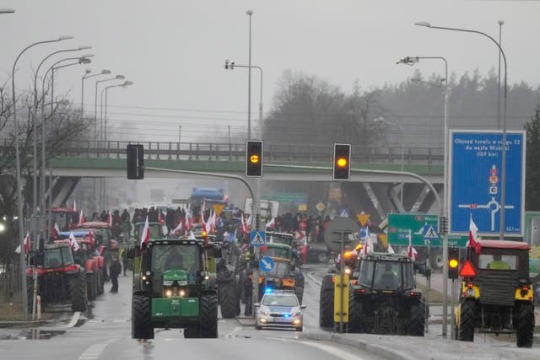
Read, Write, Repeat
Well it’s week 4 so the assignments are piling up. For a CS program, we sure do a lot of reading and writing, two of my least favorite things… (besides when it comes to the blog, I love all you readers!)
For tech ethics, we have had to read and analyze 3 lengthy papers each week discussing philosophical topics in technology and ethics. We go over the important information in class, but are expected to know key points and vocabulary, and must take a written/multiple choice quiz prior to arriving. For my communications class, we just had to complete an annotated bibliography, in which I analyzed, summarized, and reflected on two articles pertaining to recent developments in Search Engine Optimization (SEO). Analyzing the articles in my communications class was supposed to help jumpstart research for our Leadership Development challenge project on SEO.
It also feels like we’ve been doing presentations non-stop. In Leadership and Communications, it’s very common for us to get split up into groups, then research and present an assigned topic to the class. Similarly, in Databases, we get time to work on a database design or to learn a new concept (like normalization or regularization), and then present our findings to the class. I’m definitely getting better at communicating on the spot, but this teaching style is becoming quite repetitive. However, I do have some presentations I'm looking forward to in the upcoming weeks: Essential Czech (on a prominent Czech figure), Architecture (on a European site I’ve visited), and Tech Ethics (performing a technology risk analysis).
Staré Město Tour - A Recap (Old Town Square)
This week’s Architecture class tour was in Staré Město. Because of its proximity to the Old Town Square, our lecture was held in an NYU Prague campus building. A couple NYU students sat in to learn about the history of religious conflict in the region, and how it shapes Prague’s secular society today. We started off learning about European Christianization. In this period, churches were built in high gothic style, characterized by tall spires that point to heaven. They would be considered the skyscrapers of medieval Prague, demonstrating the prominence of the Church and religion in high middle age society. The central structure below, St. Nicholas Church, served as the city’s church and monestary for the elite.
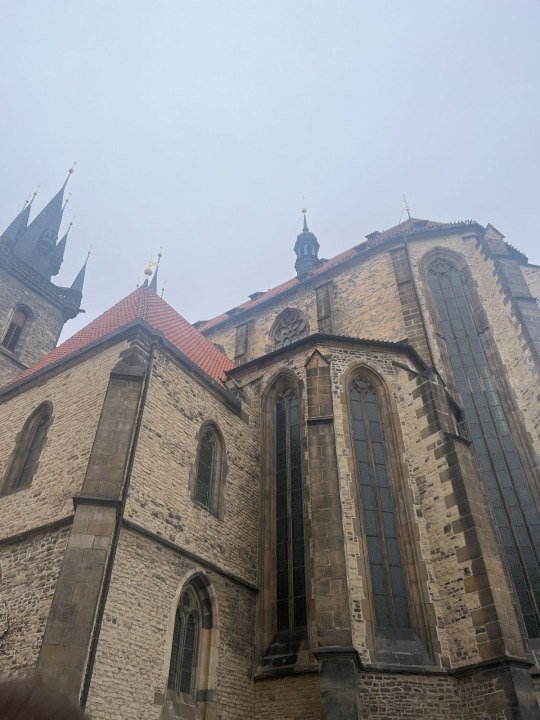
St. Nicholas was originally gothic, but was rebuilt in baroque style. Baroque was developed by the Catholics as a new cultural aspect of the Catholic Church to spread art, classical music, and more. The Protestants responded by developing their own baroque art and architecture, which spurred competition between the two Christian groups to expressively spread their creations. Prague begun to be redesigned in baroque style, characterized by high ceilings and open skies, allowing for communication with saints in heaven. Whereas gothic style focused on God, baroque focused on representing the Church as a community.
We then visited the Jan Hus memorial. Built in the early 20th century by Czech nationalists, this memorial offers a modern (re)interpretation of Jan Hus, a national Czech hero. He is depicted as a religious leader and reformer, with Hussite followers to his right. Jan Hus was sentenced to death and burnt at stake, but the Hussite group later developed into Protestant (or Bohemian) Reformation, which was an effort by Catholic clergy to reform the abuses and corruption of the medieval Church, which abused organized religion to obtain power.
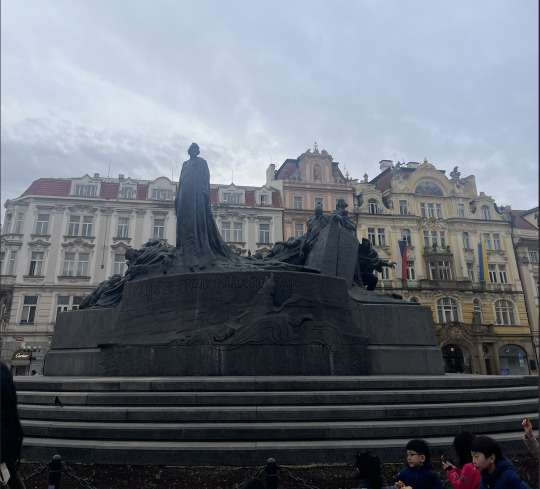
The Column of our Lady, dedicated to Mary, the mother of Jesus, stands tall beside the Jan Hus memorial. It was built after the 30 Year’s War by Emperor Ferdinand III Habsburg, as an act of thanks to God for saving Prague from the Swedish Protestant invasion in 1648. Many see the column as a symbol of Habsburg dominance and victory over Protestant minorities. However, it needed to be rebuilt after getting destroyed by Czech nationalists in 1918 when the Habsburg state collapsed. The Column is pictured below, in front of the gothic Church of Our Lady before Týn.

Finally, we saw a fragment of original medieval City Hall, pictured below. A political building representing local authority, peppered with religious symbols like apses. It even contained a Chapel inside. This is a mighty representation of how engrained religion was into politics and society in Bohemia.

Amsterdam
On Friday, I traveled to Amsterdam for my friend Samantha’s birthday! I’ve known her since we were young, but we got lucky and ended up at Michigan together. In Amsterdam, we met up with a group of 10 of her school friends who are some of my favorite people at Michigan, but I hadn’t seen them in a while, so I was excited to spend the weekend with them.
Prior to my flight, we had a mandatory guest speaker, Petr Vaclavek, from the New Venture industry. He is a venture builder, serial startup founder, and creative innovation leader, so it was interesting to learn about his journey in the start-up sector. I was expecting the talk to be more interactive, but it was more of a lecture on the current new ventures environment in Europe. I left IFSA immediately after the speaker for the airport. I flew EasyJet, and was a bit nervous about the dimensions of my bag since they were slightly over the permitted size. Of course they stopped me to check if it fit in the holder, which it didn’t, but it came close enough that they let me through without charging me to put it in the overhead compartment. Funny enough, it actually ended up fitting perfectly under the seat in front of me with dims 45cm x 35cm x 25cm.
When I got to Amsterdam, I tried to buy a transportation pass and shortly after, I hopped on a bus. Unfortunately, although the transaction went through, the pass never loaded in my email. I panicked when I saw people scanning their passes to get off the bus, and literally bolted off the bus at a random stop. I was so nervous I would get fined, but fortunately I did not get caught. I walked the rest of the way (30 mins) to the hostel to put my stuff away before meeting everyone. When I finally arrived at the group, I realized that I wasn’t in the group chat this entire time because my American phone number was added instead of my Travel number. To be honest, I simply thought Samantha was communicating the plan individually to everyone. It doesn’t make any sense to do that, but I didn't ask any questions because it was her birthday plans after all. She thought I wasn’t responding to any of the texts in the groupchat this whole time, but was like that makes soooo much more sense lol. oops!
Because we all met up on the Friday, our agenda was light and we spent most of the day walking around and peaking into thrift stores and local shops with yummy samples. Friday evening, we went to the Anne Frank House, which is now a museum. Though the house was emptied by German troops after the raid, Miep Gies was able to salvage Anne’s diary. Gies later gave it to Otto Frank, the only holocaust survivor of the Frank family, who devoted himself to editing and getting the diary published. The museum recreates the atmosphere and period of their hiding, but Otto Frank refused to refurnish the secret annex. Thus, some documents and possessions belonging to the eight people who hid there are displayed instead. The museum tour was a self-paced audioguide, which I appreciated because it was incredibly emotional and I felt like going through it by myself. I highly recommend this experience if you ever travel to Amsterdam.
On Saturday, we booked a canal cruise with unlimited wine and beer! We met some girls on our boat and ended up having some mutual friends which was a fun coincidence. It started to rain, but after a couple of drinks, no one seemed to care. The canals were beautiful and it was fun being on the water. Thankfully no one got sick on the boat…

After the cruise, we headed over to the Heineken Museum. The Heineken Experience Tour was supposed to take 2-3 hours, but we sped through it. One of the workers loved our group, so he gave us free rooftop admission and even more free drinks to top off our two complementary glasses of beer! I actually ended up liking the beer, which is extremely out of character, but I was still unable to finish a glass by myself.

No better way to end a morning bender than with French Fries, so we headed over to the highly recommended Fabel Friets! They 100% hit the spot. Afterwards, we headed back to the hostel to freshen up and get ready for the night.
What shocked me the most about Amsterdam was that people were smoking or using substances everywhere, even right in front of cops! I looked it up out of curiosity, and according to CNN, “cannabis and some types of recreational mushrooms are [illegal], but largely tolerated.” This is not the case in Prague or the US!
We packed up our things super quickly Sunday morning since checkout was at 10am, and then headed over to The Pancake Bakery for brunch! Fortunately, our hostel had free storage lockers so we didn’t have to lug our stuff everywhere. The food was incredible! We had an insane spread with omelettes, savory and sweet crepe-like pancakes, and poffertjes - mini Dutch pancakes! Finally, Amsterdam wouldn’t be complete without stopping in a candy shop, so we picked out some candy for flight back and headed to the airport. Samantha flew back to Prague with me since it’s her spring break, and we met up with some other Michigan guys at the airport who were also flying to Prague. It’s always nice having travel buddies, they keep me entertained and on time :)
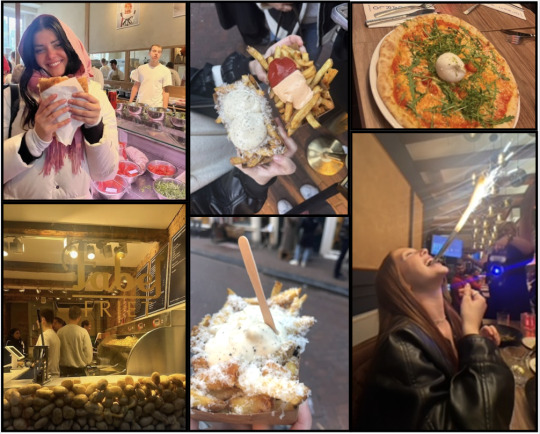
As per usual, here are some ins (things that are working) and outs (things that have been giving me trouble) for this week.
Ins:
StayOkay Hostel: This hostel was a really nice stay and was able to accommodate all 10 of us in Amsterdam. It had free WiFi, a cheap café, and was located in the center of a beautiful park! Overall highly recommend, but be sure to pack a towel if you want to take a shower!
Sewing Kit: Before leaving, I bought a sewing kit for $7 at Target. It has already come in handy for patching up a pair of jeans and one of my favorite shirts. I'll throw in bonus points for it coming with a measuring tape, which has been helpful with suitcase dimensions.
Dogs: Everyone who visits Prague absolutely LOVES the dogs roaming around everywhere without leashes! I love this for Prague :)

Outs:
O2 data: Soooo my 10GB data plan ran out, but instead of O2 letting me top-up my plan, I had to wait until the 30 day period was over to buy more. Now it’s only letting my buy data on a day-to-day basis… tragic. Will hopefully have better updates on my data plan next week.
Straightening my hair: It’s been nearly a month, and I still have yet to invest in a blow dry brush or hair straightener (shout out Lydia for letting me borrow hers). My hair is very naturally curly, so I’ve been styling it with water and my dae curl cream nearly every day. All you readers with curly hair know that maintaining nice curls is time consuming, but the beauty is worth it!
That’s all for now, I’ll see you next week!
Na schle všichni,
Reese Liebman
Computer Science and Engineering
Institute for Study Abroad (IFSA) CS Tech Career Accelerator in Prague, Czechia
0 notes
Text
Cetinje
The former capital until 1946, Cetinje was one of my favourite places in Montenegro. It was compact, and filled with lovely buildings and interesting museums. The old town centre is pedestrianised, and there isn’t much traffic anywhere else. A day there was the perfect amount of time to see literally everything.
The best views of Cetinje are from Eagle Rock, which felt harder to climb that it…

View On WordPress
#Billiard Palace#Blue Palace#British Embassy#Castle Church#Cetinje City Hall#Djukanovic Palace#Eagle Rock#Ethnographic Museum of Montenegro#French Embassy#King Nicholas Museum#Ministry of Culture#Monastery of St Paul#Money Museum#Montenegro#National Museum of Montenegro#photography#Relief of Montenegro#Russian Embassy#travel#Vlaška Church
0 notes
Text
Seoul culture🇰🇷
Museums
Seoul is home to 115 museums, including four national and nine official municipal museums. The National Museum of Korea has a collection of 220,000 artifacts. The National Folk Museum is located on the grounds of Gyeongbokgung and focuses on the daily life of historical Koreans. Bukchon Hanok Village and Namsangol Hanok Village are old residential districts consisting of hanok (traditional Korean houses).
The War Memorial covers the history of wars that Korea has been involved with, especially the Korean War.[132][133] Seodaemun Prison is a former prison built during the Japanese occupation, and is used as a historic museum. The Seoul Museum of Art, Leeum, Samsung Museum of Art, and Ilmin Museum of Art are art museums in the city.
Religious monuments
The city has buildings related to a number of religions. The Wongudan altar has been used since the Three Kingdoms Period. There are also a number of Confucian shrines, such as Jongmyo, Sajikdan, Munmyo, and Dongmyo. For Buddhism, Jogyesa is the headquarters of the Jogye Order of Korean Buddhism. Hwagyesa and Bongeunsa are also major Buddhist temples in Seoul.
The Myeongdong Cathedral is a landmark of the Myeongdong, Jung District. Yakhyeon Catholic Church is the first Gothic church to be built in Korea. Yoido Full Gospel Church is a Pentecostal church affiliated with the Assemblies of God on Yeouido in Seoul. The St. Nicholas Cathedral, but sometimes called bald church, is the only Byzantine-style church in Seoul.
Festivals
In October 2012, KBS Hall in Seoul hosted major international music festivals – First ABU TV and Radio Song Festivals within frameworks of Asia-Pacific Broadcasting Union 49th General Assembly. Hi! Seoul Festival is a seasonal cultural festival held four times a year every spring, summer, autumn, and winter in Seoul, South Korea since 2003. It is based on the "Seoul Citizens' Day" held on every October since 1994 to commemorate the 600 years history of Seoul as the capital of the country. The festival is arranged under the Seoul Metropolitan Government. As of 2012, Seoul has hosted Ultra Music Festival Korea, an annual dance music festival that takes place on the 2nd weekend of June.
Seoul has a large quantity of parks. One of the most famous parks is Namsan Park, which offers recreational hiking and views of the downtown Seoul skyline, especially via its N Seoul Tower. Seoul Olympic Park, located in Songpa District and built to host the 1988 Summer Olympics, is the largest park. The areas near the stream Tancheon are popular for exercise. Cheonggyeche
Architecture 🏙️
The traditional heart of Seoul is the old Joseon dynasty city, now the downtown area, where most palaces, government offices, corporate headquarters, hotels, and traditional markets are located. Cheonggyecheon, a stream that runs from west to east through the valley before emptying into the Han River, was for many years covered with concrete, but was recently restored by an urban revival project in 2005. Jongno street, meaning "Bell Street", has been a principal street and one of the earliest commercial streets of the city, on which one can find Bosingak, a pavilion containing a large bell. The bell signaled the different times of the day and controlled the four major gates to the city. North of downtown is Bukhan Mountain, and to the south is the smaller Namsan. Further south are the old suburbs, Yongsan District and Mapo District. Across the Han River are the newer and wealthier areas of Gangnam District, Seocho District and surrounding neighborhoods.
Historical architecture
Seoul has many historical and cultural landmarks. In Amsa-dong Prehistoric Settlement Site, Gangdong District, neolithic remains were excavated and accidentally discovered by a flood in 1925.
Urban and civil planning was a key concept when Seoul was first designed to serve as a capital in the late 14th century. The Joseon dynasty built the "Five Grand Palaces" in Seoul—Changdeokgung, Changgyeonggung, Deoksugung, Gyeongbokgung and Gyeonghuigung—all of which are located in the Jongno and Jung Districts. Among them, Changdeokgung was added to the UNESCO World Heritage List in 1997 as an "outstanding example of Far Eastern palace architecture and garden design". The main palace, Gyeongbokgung, underwent a large-scale restoration project. The palaces are considered exemplary architecture of the Joseon period. Beside the palaces, Unhyeongung is known for being the royal residence of Regent Daewongun, the father of Emperor Gojong at the end of the Joseon Dynasty.
Seoul has been surrounded by walls that were built to regulate visitors from other regions and protect the city in case of an invasion. Pungnap Toseong is a flat earthen wall built at the edge of the Han River, which is widely believed to be the site of Wiryeseong. Mongchon Toseong is another earthen wall built during the Baekje period that is now located inside the Olympic Park. The Fortress Wall of Seoul was built early in the Joseon dynasty for protection of the city. After many centuries of destruction and rebuilding, about 2⁄3 of the wall remains, as well as six of the original eight gates. These gates include the south gate Namdaemun and the east gate Dongdaemun. Namdaemun was the oldest wooden gate until a 2008 arson attack, and was re-opened after complete restoration in 2013. Located near the gates are the traditional markets and largest shopping center, Namdaemun Market and Dongdaemun Market.

Modern architecture
Various high-rise office buildings and residential buildings, like the Gangnam Finance Center, the Tower Palace, Namsan Seoul Tower, and the Lotte World Tower, dominate the city's skyline. The tallest building is Lotte World Tower, reaching a height of 555m. It opened to the public in April 2017. It is also the 6th highest building in the world.
The World Trade Center Seoul, located in Gangnam District, hosts various expositions and conferences. Also in Gangnam District is the COEX Mall, a large indoor shopping and entertainment complex. Downstream from Gangnam District is Yeouido, an island that is home to the National Assembly, major broadcasting studios, and a number of large office buildings, as well as the Korea Finance Building and the Yoido Full Gospel Church. The Olympic Stadium, Olympic Park, and Lotte World are located in Songpa District, on the south side of the Han River, upstream from Gangnam District. Three new modern landmarks of Seoul are Dongdaemun Design Plaza & Park, designed by Zaha Hadid, the new wave-shaped Seoul City Hall, by Yoo Kerl of iArc, and the Lotte World Tower, the 6th tallest building in the world designed by Kohn Pedersen Fox.
In 2010 Seoul was designated the World Design Capital for the year.

1 note
·
View note
Text
10 tiny towns in the Czech Republic with an interesting history

Almost every seemingly secluded and tiny corner of the Czech Republic actually hides wonders - breathtaking historical buildings and attractions. We have prepared ten picturesque Czech towns that can be a real find for a traveler.
Cesky Krumlov
Possessing a special energy, Cesky Krumlov, despite its rather modest size, would be hard pressed to call it a single-use city. Travelers admit that with its leisurely rhythm and ancient charm, the town makes you fall in love the first time and makes you think about returning here again and again. By the way, the most beautiful and interesting part of the city territory, the historical center, is a UNESCO World Heritage Site, so its significance is difficult to overestimate.
Key Attractions: Krumlov Castle, historical center, Church of St. Vitus

Photo by - prostovisa
Kunta Gora
And this city is a real treasure trove of a wide variety of historical attractions - from a Gothic temple to a medieval silver mine. But, perhaps, one of the most interesting places in this region is the ossuary, located in the near suburb of Kutna Hora - Sedlec. In fact, this frightening and at the same time attractive attraction is a church entirely created from the bones of thousands of people. Every year, thousands of tourists come to the Czech Republic to see one of the largest such buildings with their own eyes.
Key Attractions: Ossuary, Cathedral of St. Barbara, Church of the Assumption of the Virgin Mary and St. John the Baptist

Photo by - badenguide
Olomouc
Olomouc is often (and I must say, quite deservedly) ranked among the Czech cities that can easily compete with Prague itself in the fight for the traveler’s attention. It is not surprising, because in its small territory there is such a significant concentration of historical attractions that the capital would be envious. Just by starting a walk around the city, you can find something almost everywhere worthy of a place on your Instagram - the local baroque squares and fountains are extremely photogenic.
Key Attractions: Column of the Holy Trinity, St. Wenceslas Cathedral, Church of St. Mauritius
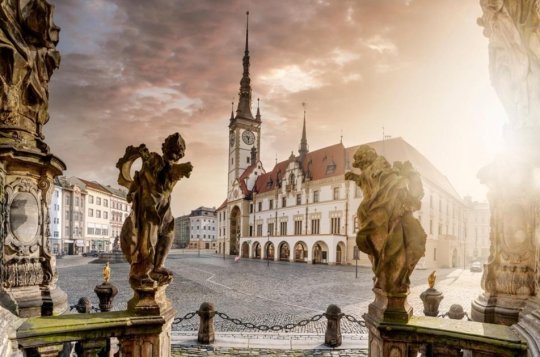
Photo by zakavto
Turnov
In addition to boasting a rich and eventful history, Turnov is also fortunate to be located in a region with breathtaking natural scenery, and it is no coincidence that it is often chosen as a starting point for independent travel in Czech Bohemia. Walking around the town, you just need to look around - everything here is beautiful and exciting. And also, for the information of lovely ladies, this is where the Czech pomegranate factory is located, where you can buy stone products at reasonable prices.
Key attractions: Old town, ancient Church of St. Nicholas

Photo by - miraxtravel
Karlstein
Karlštejn is the name of a luxurious fortress that should take its rightful place on our list. The castle was prudently built on a high cliff covered with greenery, which gives it even more charm. At the foot of this hill lies a tiny settlement of the same name.
Key Attractions: Karlstejn fortress

Photo by - miraxtravel
Trebon
Treboň is not only the cradle of the country's rich historical heritage, but also the birthplace of the best creators of local history: composer Josef Tribenze, as well as Czech football star Karel Poborský.
Key Attractions: Church of St. Elizabeth, Trebon Castle, ramparts

Photo by - narvikk
Marianske Lazne
Guests from all over the world flock here in an inexhaustible stream - primarily to drink water from local sources and improve their health. The healing power of this place was once experienced by Chopin, Wagner, Goethe (their house-museums and monuments can be visited in the city today) and many others. A pleasant bonus for vacationers has always been the opportunity to enjoy the beauty of this cozy garden city.
Key Attractions: singing fountain, house-museum "Monument to Chopin", monument to Goethe

Photo by - marianskelazne
Cheb
By the way, the same Goethe was clearly partial to another tiny pearl of the Czech Republic - the town of Cheb in the region of the same name. Its streets are remembered even more - life has been in full swing here since the times of the Holy Roman Empire. In its modern form, Cheb is a calm and prim, but culturally quite developed town with well-preserved examples of buildings from the early Middle Ages.
Key Attractions: Imperial Palatinate, St. George's Square, St. Nicholas Church

Photo by traveler
Ceske Budejovice
This town became popular many centuries ago, immediately after its founding, because it was here that many European trade routes converged: both land and water (the city is washed by two rivers). All this, of course, contributed to its systematic development in various styles. Travelers can still enjoy the fruits of urban development of those times by taking a walk around Ceske Budejovice.
Key Attractions: Samson statue in the city square, Town Hall, Black Tower, Dominican monastery
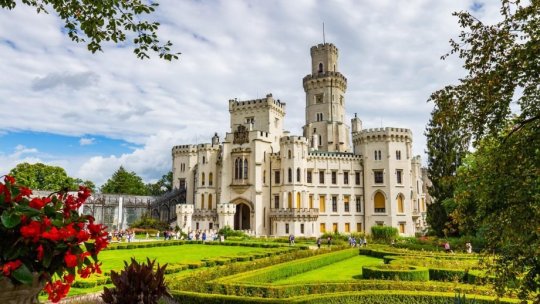
Photo by diez
Beneshov
And this neat town, in its rather long history, has survived many turmoil, raids, wars and even arson. However, by some miracle, the town still survived and today happily welcomes guests, showing them the surviving sights. In addition, in the immediate vicinity of Benesov there is perhaps the most beautiful castle in the Czech Republic - the luxurious Konopiste, made in the Gothic style.
Key Attractions: Church of St. Nicholas, Church of St. Anne

Photo by - pragagid
Read the full article
1 note
·
View note
Text
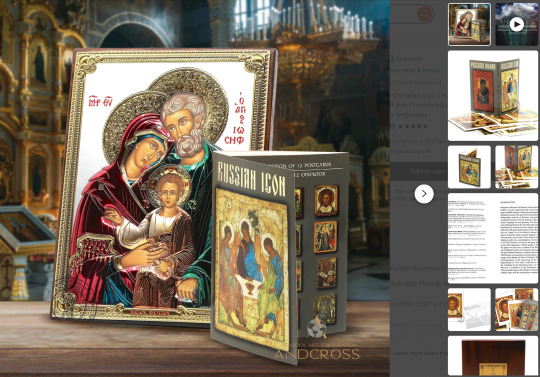

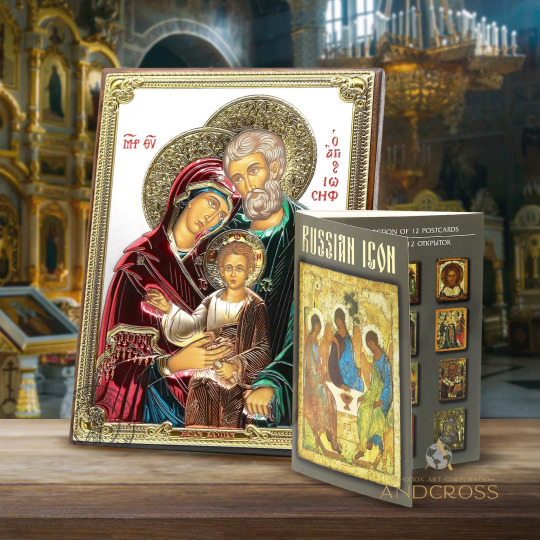
Silver-Plated Icon 999 | (5.12" x 7.1") 13 x 18 cm
Title: The Holy Family | Orthodox Icon | Handmade | Silver-Plated Icon 999 | (5.12" x 7.1") 13 x 18 cm
Highlights: handmade, consecrated
Materials: wood, 999 silver, gift box
And a collection of 12 rare postcards - RUSSIAN ICON
RUSSIAN ICONS - A COLLECTION OF 12 RARE POSTCARDS
The Archangel Gabriel (Angle with the Golden Hair)
The Miracle of St George
The Battle of the Novgorodians and the Suzdalians. The Miraculous Sign of the Icon of the Virgin
The Trinity by Andrey Rublev
St John the Theologian in Silence
Sts Boris and Gleb
The Entry into Jerusalem
The Mother of God of Vladimir
Icon Not-Made-by-Hand of Our Lord
The Baptism of Christ
St Nicholas with Selected Saints (on the borders)
Kazan Icon of the Mother of God
The titles of these icons are written in five languages (Russian, English, German, French, and Japanese), which only proves the international value of the Russian art of icon painting.
This set of postcards includes some impressive examples of Russian Orthodox icon painting. Some of these icons can only be found in museums and reflect the history of the development of icon painting in the country throughout the centuries. Every period is represented here: the early stage (the 12th century) when the artists were taking lessons from the famed Byzantine masters, the era of flourishing (the 14th and 15th centuries) when independent schools of icon painting in Russia were established, and the late stage (the 16th century) dedicated to discovering theological meanings and finding the unique artistic side.
The multifaceted diversity of Russian icon painting schools is shown in the works. Thus, the Novgorod icons are notable for their brightness, and positive vibes in the colour palette, and at the same time, they convey infinite spiritual power. It’s visible in such works as The Baptism of Christ and Icon Not-Made-by-Hand of Our Lord.
As if opposing this brightness, there are the Pskov icons, which stand out because of their dark colours. Another approach to icon painting is shown by the Moscow School – the visible inner harmony and serenity as in Andrey Rublev’s famous work The Trinity. And although it’s a widely-known motif for many believers, the painting and the talent of the artist turned it into one of the most prominent works of Russian art.
Another change in Russian icon painting was influenced by the appearance of The Mother of God of Vladimir. This image was not made in Russia – its birthplace is Constantinople. Brought to Kyiv at the beginning of the 12th century, it stayed in the Holy Dormition Cathedral until 1480. It was later transferred to Moscow but regardless of its resting place, has always had immersive power over believers. And even more: the striking beauty of the Mother of God and her genuine mournful features ranks this image as one of the most perfect portraits in the world of art
Description:
THE REPLICA OF JERUSALEM ICON CONSECRATED IN A CHURCH
1 HANDMADE ICON + GIFT CASE
ICON SIZE: 13 x 18 cm (5.12 x 7.1 inches)
The Holy Family is one of the most common souvenirs that pilgrims and tourists bring from Jerusalem. Even without visiting the Holy Land, you can make a generous gift for your loved ones and order the Holy Family icon online in our store. This handmade icon can turn into a family heirloom and serve as home decor. This is the exact reproduction of Jerusalem icons, which is made with the blessing of the clergy.
This is a rare depiction that cannot be found in many churches: typically, Joseph is not portrayed with the Virgin Mary and Baby Christ in sacred images. However, it serves as a great reminder of the human origins of Our Saviour and the importance of family ties. The Holy Family is a frequent gift for a newly wedded couple, wedding anniversaries, or for the birth of the first child. It will become a great and meaningful home decor for any couple.
The image on the icon makes its meaning and purpose quite clear for all believers. The Holy Family is a symbol of strong bonds that bind a man and a woman, mutual understanding between the spouses, and their responsibility for each other and their children. The portrayal of the Holy Family is so vivid that it looks like a photo from a family album – warm and radiating love and happiness. This is the example of an ideal family, which everyone should strive for.
Believers turn to this image if there are problems in the family: frequent fights and misunderstandings between husband and wife, conflicts with children, infidelities, or loss of warmth and affection. Single people ask the sacred image to help them meet a worthy spouse. Anyone can turn to the Holy Family with requests for protecting his family and giving health to all relatives.
[MATERIALS AND PRODUCTION]
Only quality materials were used for crafting this item: high-density wood and 999 fine silver. Thanks to the solid wooden stand, it can be placed on the shelf or the table.
The product is handmade by Orthodox craftsmen who work with prayer and devotion to what they do. You can be confident in the spiritual value of this sacred image.
[DIMENSIONS] The size of the icon is 13 x 18 cm (5.12" x 7.1").
[SHIPPING & DELIVERY]
Standard delivery: 5-20 business days, depending on the destination. All our products are shipped from Estonia. You can also request expedited shipping: just send us a message and we’ll get back to you.
Feel free to message us if there are any questions about the selection of Orthodox goods or our mission!
The Andcross Orthodox Art Corporation responds to all incoming requests.
#orthodox icon#greek orthodox#orthodox monastery#orthodox#orthodox church#eastern orthodoxy#orthodox christianity#russian orthodox#orthodox christmas#The Holy Family
1 note
·
View note
Text
Dr. Mary Travelbest - Venice Italy
In this episode, The Venice Episode,
FAQ’s are:
1. What about the possibility that the museums and galleries may not accurately represent the true history and experiences of these famous individuals?
2. Have you considered tourism's impact on preserving historical landmarks and artifacts and is it sinking?
3. How would you address those who argue that the cultural significance of these figures is exaggerated or overemphasized in the tourism industry?
The answers: Yes, it’s sinking, but slowly. Some of the historical figures may have been misrepresented. You still have time to explore the city. Is tourism here overrated? Listen for more following.
Today’s Destination is Venice, Italy
Today’s Mistake- TSA found squash in my suitcase
Travel Advice: Border crossing into Mexico
Today’s destination: Venice, Italy
Venice is a cultural center of Italy with 117 islands, 400 bridges, and 150 canals. The Grand Canal is the city's main artery and a must-see. While taking a gondola ride may seem corny, expensive, and embarrassing, there are plenty of other ways to explore the city. Fewer people live in Venice nowadays due to the city's sinking and high prices, but the region still attracts many tourists, Hollywood royalty, and artists.
A trip to Venice is incomplete without trying the seafood and espresso and visiting St Mark's Cathedral. The city's history is also rich with connections to famous figures such as Marco Polo, Casanova, and Vivaldi. I did not visit the museums, but I did see many of the churches here. There’s always next time, and I have seen museums in many other Italian cities. I wanted to be outside in the fresh air.
If you want to escape the crowds, venture out at dawn and get lost in the back alleys to discover magnificent churches and smelly canals. The Merchant of Venice, by Shakespeare, is another cultural treasure that can be enjoyed here.
While some private swim clubs charge 50 euros to swim, you can visit Saint Elena and Saint Mary Elizabeth at the end of the ferry’s Line 1 for a refreshing dip in the Adriatic Sea for free, as I did.
The Lido, St Nicholas of Tolentine Mass, and the train station are other notable destinations to visit. Be sure to bring an umbrella for shade and learn some Italian words to immerse yourself fully in the local culture.
Lastly, take the ferries everywhere to get around the city and enjoy the relaxed vibe of patient tourists walking and waiting. The Anda hostel near the train station is a recommended place to stay. While tickets to the Opera House may not be available at the last minute, this beautiful city has plenty of other cultural experiences. A day ticket on the ferries is cheap. Trains are all with AC
Today’s Mistake- TSA found squash in my suitcase
I grow vegetables and wanted to share the fruit of my crop with a friend. It was a surprise when TSA asked me to open my luggage to show them my squash. Oh well, that was just an unusual object for someone to carry in their bag.
Today’s Travel Advice- Border crossing into Mexico
If you are crossing the US border into Mexico, consider that the experience is always changing. Some days, the line will be long; other times, it could be shorter.
The last time I was there, it took 4 hours in the car to cross back to the USA. That is ideal if you all have a Global Entry and your car is registered. The wait will be short. You can also drop passengers off, and they walk across while you drive your Sentri-cleared vehicle across.
There could also be a long wait going to Mexico, so be prepared by checking in advance and getting auto insurance before you leave.
Connect with Dr. Travelbest
5Stepstosolotravel.com
Drmarytravelbest.com
Dr. Mary Travelbest Twitter
Dr. Mary Travelbest Facebook Page
Dr. Mary Travelbest Facebook Group
Dr. Mary Travelbest Instagram
email: [email protected]
Dr. Mary Travelbest Podcast
Dr. Travelbest on TikTok
Dr.Travelbest onYouTube
Check out this Dr Travelbest episode!
0 notes